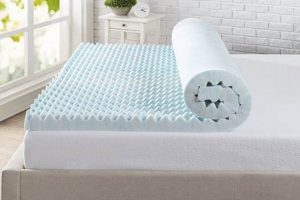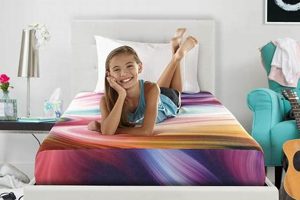A sleeping surface designed to optimize comfort and support for children represents a significant purchase for many families. The qualities differentiating such a product often include appropriate firmness, non-toxic materials, and features catering to common childhood needs, such as spill resistance and hypoallergenic properties. For instance, a mattress utilizing CertiPUR-US certified foam and a waterproof cover would exemplify such a product.
Selecting the appropriate sleeping surface for a child contributes substantially to their sleep quality and overall well-being. Adequate rest supports healthy physical and cognitive development, while a poorly chosen mattress could potentially lead to discomfort, restlessness, or even exacerbate allergies. Historically, advancements in sleep science and material technology have led to increasingly sophisticated and specialized mattresses for children.
The subsequent sections will delve into the key factors to consider when evaluating a sleeping surface for children, including material composition, safety certifications, size and support considerations, and the practical aspects of maintenance and longevity. Understanding these elements is crucial for making an informed decision that prioritizes a child’s health and restful sleep.
Essential Considerations for Selecting a Child’s Mattress
Choosing a mattress for a child necessitates careful evaluation. The following guidelines address crucial aspects to ensure the selected product supports healthy sleep and physical development.
Tip 1: Prioritize Material Safety and Certifications: Look for mattresses with certifications such as CertiPUR-US, GREENGUARD Gold, or OEKO-TEX Standard 100. These certifications indicate that the mattress has been tested for harmful chemicals and emissions, promoting a healthier sleep environment for the child.
Tip 2: Assess Firmness Level Based on Age and Weight: Infants and toddlers require a firmer surface to reduce the risk of suffocation and SIDS. As children grow, a medium-firm mattress may provide a more comfortable balance of support and pressure relief. Consider the child’s weight and sleeping position when making this determination.
Tip 3: Evaluate Mattress Size Appropriately: A standard crib mattress suits infants and toddlers in a crib. As the child transitions to a bed, consider a twin or full-size mattress. Factor in the child’s height, room size, and anticipated future growth when deciding on the appropriate dimensions.
Tip 4: Consider Hypoallergenic and Antimicrobial Properties: Children are often susceptible to allergies. Opt for mattresses made with hypoallergenic materials and consider those with antimicrobial treatments to inhibit the growth of mold, mildew, and bacteria, further minimizing potential allergens.
Tip 5: Examine Waterproof or Water-Resistant Features: Accidents and spills are common occurrences with young children. A mattress with a waterproof or water-resistant cover will protect the inner layers from moisture damage, prolonging its lifespan and preventing the growth of mold.
Tip 6: Inquire About the Mattress’s Edge Support: Strong edge support prevents sagging and allows the child to utilize the entire surface of the mattress comfortably. This is particularly important for children who tend to roll towards the edge during sleep.
Tip 7: Review Warranty and Return Policies: A comprehensive warranty demonstrates the manufacturer’s confidence in the product’s quality and durability. A generous return policy allows for a trial period to assess the mattress’s suitability for the child’s needs.
Choosing a mattress requires balancing factors such as safety, support, durability, and allergy considerations. Carefully reviewing these aspects will result in a selection that promotes optimal sleep and long-term well-being for the child.
The following section presents a summary of top-rated mattresses for children based on independent testing and consumer reviews.
1. Firmness Level
Firmness level constitutes a critical attribute when selecting an appropriate sleeping surface for children. Its impact extends to spinal alignment, safety, and overall sleep quality, thereby influencing long-term health and development. Evaluating firmness requires considering age-specific needs and potential implications for physical well-being.
- Infant and Toddler Safety
For infants and toddlers, a firmer mattress is recommended to minimize the risk of Sudden Infant Death Syndrome (SIDS). A firm surface prevents indentation and reduces the likelihood of suffocation should the child roll over during sleep. Regulations and pediatric guidelines often stipulate minimum firmness standards for crib mattresses to ensure a safe sleep environment. Non-compliant mattresses present a potential hazard.
- Spinal Development and Support
As children grow, the firmness requirement shifts to accommodate spinal development and provide adequate support. A medium-firm mattress typically suits older children, offering a balance between support and pressure relief. Insufficient support can contribute to poor posture and discomfort, while excessive firmness may lead to pressure points and restlessness. Proper spinal alignment promotes healthy growth and minimizes potential musculoskeletal issues.
- Weight Distribution and Comfort
Firmness directly affects weight distribution across the sleeping surface. An appropriately firm mattress distributes weight evenly, reducing pressure on specific areas such as the shoulders and hips. This is particularly important for children who sleep on their sides. Uneven weight distribution can lead to discomfort, tossing and turning, and disrupted sleep cycles. Mattress selection should consider the child’s weight and preferred sleeping position.
- Longevity and Durability
Firmness contributes to the overall longevity and durability of a mattress. A mattress that is too soft may sag prematurely, reducing its supportiveness and lifespan. Higher-density foams and innerspring systems contribute to maintaining the intended firmness level over time. Selecting a mattress with durable construction ensures consistent support and extends the product’s usable life, representing a cost-effective investment.
The optimal firmness level represents a critical element in defining the parameters of a suitable sleeping surface for children. Balancing safety considerations for infants with the developmental needs of older children dictates a nuanced approach. Selecting a mattress that addresses these firmness-related factors contributes substantially to the child’s comfort, health, and overall well-being, reinforcing its role in the overall assessment of a “best kid mattress”.
2. Safety Certifications
Safety certi
fications represent a cornerstone in evaluating the suitability of a mattress for children, significantly impacting its classification as a “best kid mattress.” These certifications, issued by independent testing organizations, verify that a mattress meets specific safety standards regarding chemical emissions, flammability, and material composition. Their presence directly correlates with a reduced risk of exposure to harmful substances, thereby mitigating potential health concerns for the child. For example, a mattress bearing the CertiPUR-US certification signifies that the foam components have been tested and certified to be free from prohibited phthalates, ozone depleters, heavy metals, formaldehyde, and volatile organic compounds (VOCs), demonstrating a commitment to minimizing indoor air pollution and potential health risks. The absence of such certifications raises concerns about potential hazards, influencing the product’s ranking within the spectrum of available options.
The practical significance of understanding safety certifications lies in enabling informed purchasing decisions. Parents and caregivers, armed with this knowledge, can prioritize mattresses that demonstrably minimize exposure to harmful chemicals. This proactive approach reduces the likelihood of allergic reactions, respiratory irritations, and other potential adverse health effects associated with unregulated materials. Consider the GREENGUARD Gold certification, which indicates that a product has been tested for over 10,000 chemicals and VOCs, ensuring that it meets stringent emission standards for indoor air quality. Mattresses bearing this mark are often preferred choices for nurseries and children’s rooms, reflecting a commitment to creating a healthier sleep environment. Conversely, mattresses lacking credible certifications may contain undisclosed chemicals or materials that pose health risks, underscoring the importance of verifying these credentials prior to purchase.
In summary, safety certifications serve as an objective benchmark for evaluating the health and safety attributes of a mattress. They provide consumers with valuable assurance regarding the composition and potential impact of the product on a child’s well-being. Prioritizing mattresses with established safety certifications is integral to identifying a “best kid mattress,” reflecting a commitment to minimizing risks and promoting a healthy sleep environment. The challenges lie in ensuring that certifications are legitimate and continuously updated to reflect evolving safety standards, requiring ongoing vigilance from both manufacturers and consumers. Ultimately, the presence of verifiable safety certifications links directly to the overall safety and suitability of a mattress for children, solidifying its role as a key determinant in product selection.
3. Material toxicity
Material toxicity represents a critical concern when evaluating mattresses intended for children. The selection of a “best kid mattress” hinges significantly on minimizing exposure to harmful chemicals and ensuring the use of safe, non-toxic components. Failure to address this aspect can lead to adverse health effects and compromised well-being.
- Foam Composition and VOCs
Many mattresses utilize polyurethane foam, which can emit volatile organic compounds (VOCs). These VOCs may include formaldehyde, benzene, and toluene, known irritants and potential carcinogens. A “best kid mattress” prioritizes foams with low or zero VOC emissions, often certified by independent organizations, to mitigate respiratory irritation and long-term health risks associated with inhalation of these chemicals.
- Flame Retardants and Health Implications
Conventional mattresses frequently incorporate flame retardants to meet flammability standards. However, certain flame retardants, such as polybrominated diphenyl ethers (PBDEs), have been linked to endocrine disruption and developmental issues. A responsible “best kid mattress” employs alternative, non-toxic flame retardant solutions, such as silica or wool, to comply with safety regulations without compromising the child’s health.
- Adhesives and Chemical Sensitivities
Adhesives used in mattress construction can also release harmful chemicals, contributing to indoor air pollution and triggering sensitivities in susceptible individuals. A “best kid mattress” relies on water-based or solvent-free adhesives that minimize off-gassing and reduce the risk of allergic reactions or chemical sensitivities in children, promoting a healthier sleep environment.
- Textile Treatments and Allergen Exposure
Mattress textiles may undergo treatments with various chemicals to enhance stain resistance or antimicrobial properties. Some of these treatments can contain allergens or irritants that negatively affect children with sensitivities. A thoughtfully designed “best kid mattress” utilizes organic or naturally derived textile treatments, minimizing the potential for allergic reactions and maintaining a safe and healthy sleeping surface.
Addressing material toxicity is paramount in the selection of a “best kid mattress.” Prioritizing mattresses that utilize certified non-toxic materials, minimize chemical emissions, and avoid harmful additives promotes a safer and healthier sleep environment for children, mitigating potential health risks and supporting their overall well-being. Consumers must diligently research and verify material composition to ensure they are selecting a mattress that aligns with these critical safety considerations.
4. Spill Resistance
Spill resistance represents a significant attribute in the context of selecting a suitable mattress for children. The inherent vulnerability of mattresses to liquid penetration necessitates careful consideration of spill-resistant features when evaluating products for this demographic.
- Protection Against Staining and Odor
Spills, whether from bodily fluids, food, or beverages, can lead to permanent staining and lingering odors within a mattress. These stains not only detract from the mattress’s appearance but can also harbor bacteria and allergens. Spill-resistant mattresses, typically featuring a waterproof or water-resistant cover, effectively prevent liquids from penetrating the inner layers, thus minimizing the risk of staining and odor retention.
- Prevention of Mold and Mildew Growth
Moisture penetration into a mattress creates an environment conducive to the growth of mold and mildew. These microorganisms can trigger allergic reactions and respiratory problems, posing a significant health risk, especially for children with sensitivities. Spill-resistant covers mitigate this risk by preventing moisture accumulation within the mattress, inhibiting the growth of mold and mildew. Maintaining a dry and hygienic sleep surface is crucial for promoting respiratory health.
- Extended Mattress Lifespan
Repeated exposure to spills can degrade the internal components of a mattress, such as foam and fiber layers, leading to premature wear and tear. Liquid penetration can compromise the structural integrity of the mattress, diminishing its support and comfort levels over time. Spill-resistant features protect the mattress from moisture damage, prolonging its lifespan and maintaining its performance characteristics.
- Ease of Cle
aning and MaintenanceSpill-resistant mattresses simplify the cleaning process following an accident. The waterproof or water-resistant cover allows for easy wiping of spills, preventing them from seeping into the mattress. This ease of cleaning reduces the effort required to maintain a hygienic sleep environment, offering convenience for caregivers.
The aforementioned facets illustrate the importance of spill resistance in the overall assessment of a mattress designed for children. The benefits of stain and odor prevention, mold and mildew control, extended lifespan, and ease of cleaning collectively contribute to a healthier, more durable, and more manageable sleep environment, enhancing the product’s value proposition within the “best kid mattress” category. The inclusion of effective spill-resistant features therefore aligns directly with prioritizing hygiene, longevity, and ease of care, core criteria in selecting a sleeping surface for children.
5. Hypoallergenic
The designation “hypoallergenic,” when applied to a mattress intended for children, signifies a design and construction approach aimed at minimizing allergenic triggers. Children, often more susceptible to allergies than adults, benefit significantly from a sleep environment that reduces exposure to common allergens such as dust mites, mold spores, pet dander, and certain chemicals. A “best kid mattress,” therefore, frequently incorporates hypoallergenic materials and features as a core component, reflecting a commitment to promoting respiratory health and minimizing allergic reactions. The cause-and-effect relationship is direct: reduced allergen exposure results in decreased incidence of allergic symptoms, leading to improved sleep quality and overall well-being. For example, a mattress encased in a tightly woven fabric, designed to prevent dust mite penetration, exemplifies a practical application of hypoallergenic principles. Similarly, mattresses utilizing natural latex, known for its inherent resistance to mold and dust mites, demonstrate a commitment to minimizing allergen sources.
The importance of the “hypoallergenic” characteristic in a child’s mattress extends beyond merely reducing allergic symptoms. Chronic exposure to allergens can contribute to the development of more severe respiratory conditions, such as asthma. A hypoallergenic mattress, therefore, serves as a preventative measure, reducing the likelihood of developing or exacerbating such conditions. Practical applications of this understanding include the selection of mattresses certified by organizations like the Asthma and Allergy Foundation of America (AAFA), which independently tests and certifies products that meet specific standards for allergen reduction. Furthermore, the use of materials like organic cotton and wool, known for their natural hypoallergenic properties and breathability, further enhances the overall effectiveness of a mattress in minimizing allergen exposure. The practical significance lies in empowering parents and caregivers to make informed decisions that prioritize the child’s respiratory health.
In conclusion, the inclusion of hypoallergenic features is not merely an optional add-on but a fundamental aspect of what defines a “best kid mattress.” By minimizing allergen exposure, these mattresses contribute directly to improved respiratory health, reduced allergic symptoms, and a higher quality of sleep. The challenges lie in ensuring that claims of hypoallergenic properties are substantiated by credible certifications and that materials are genuinely free from common allergens. Ultimately, a comprehensive understanding of hypoallergenic principles and their practical applications is crucial for selecting a mattress that truly promotes the well-being of the child, addressing concerns and reinforcing its value.
6. Size Suitability
The appropriateness of a mattress’s dimensions constitutes a fundamental consideration in the selection process, significantly influencing its classification as a “best kid mattress.” The correlation between size suitability and a child’s developmental needs, room constraints, and long-term usage requirements necessitates a thorough evaluation of available options.
- Crib Mattress Dimensions and Infant Safety
Crib mattresses adhere to standardized dimensions to ensure a secure fit within crib frames. Deviations from these standards pose a safety risk, potentially leading to entrapment or suffocation. A “best kid mattress” designed for infants conforms precisely to established crib dimensions, mitigating these hazards and promoting a safe sleep environment. Regulatory bodies mandate specific size tolerances for crib mattresses to ensure compliance with safety standards.
- Transition to Twin or Full Size and Developmental Stages
As children transition from cribs to beds, the selection of an appropriately sized mattress becomes paramount. Twin or full-size mattresses offer increased sleeping space to accommodate growth and movement. A “best kid mattress” in these larger sizes provides adequate support and comfort for older children, promoting restful sleep and optimal spinal alignment. The choice between twin and full depends on factors such as room size, the child’s individual needs, and anticipated future growth.
- Room Dimensions and Spatial Considerations
The physical dimensions of the child’s bedroom dictate the maximum allowable mattress size. A “best kid mattress” should fit comfortably within the available space, allowing for sufficient room to navigate around the bed and engage in other activities. Overly large mattresses can create a cramped environment, impeding movement and potentially affecting sleep quality. Careful measurement of the room and consideration of furniture placement are essential when determining appropriate mattress dimensions.
- Long-Term Usability and Growth Potential
Selecting a mattress size that accommodates future growth can extend its usability and represent a cost-effective investment. A “best kid mattress” should provide ample space for the child to grow comfortably without requiring frequent replacement. Full-size mattresses, for example, can accommodate older children and teenagers, offering a longer lifespan compared to twin-size options. Anticipating future needs and selecting a mattress size accordingly can maximize its value and longevity.
In summary, size suitability is an intrinsic component in defining the parameters of a “best kid mattress.” Balancing safety considerations for infants with the evolving needs of older children, alongside spatial limitations and long-term usability, contributes to a comprehensive assessment. Selecting a mattress that addresses these size-related factors promotes comfort, safety, and value, reinforcing its significance in the overall evaluation process.
7. Edge Support
Edge support, often an overlooked feature, plays a significant role in the overall quality and safety of a mattress intended for children. Its presence directly impacts the usable surface area, stability, and longevity of the product, thereby influencing its consideration as a “best kid mattress.” A mattress lacking adequate edge support
may compromise these factors, detracting from its suitability for young users.
- Increased Usable Surface Area
Strong edge support maximizes the available sleeping surface. Children, particularly restless sleepers, often utilize the entire mattress, including the edges. Without adequate reinforcement, the edges may compress or sag, reducing the usable area and potentially causing discomfort or a feeling of instability. A “best kid mattress” provides consistent support across its entire surface, ensuring a comfortable and secure sleeping environment.
- Enhanced Stability and Reduced Roll-Off Risk
Robust edge support enhances the overall stability of the mattress, reducing the likelihood of a child rolling off during sleep. This is particularly crucial for younger children who may not have fully developed motor skills or spatial awareness. A well-supported edge provides a firm boundary, preventing accidental falls and promoting a sense of security. Mattresses with weak or non-existent edge support present a higher risk of roll-off incidents.
- Improved Durability and Longevity
Consistent edge support contributes to the long-term durability of the mattress. Without adequate reinforcement, the edges are more susceptible to wear and tear, leading to sagging and deformation over time. This can compromise the structural integrity of the mattress and reduce its lifespan. A “best kid mattress” incorporates durable edge support to withstand regular use and maintain its shape and supportiveness for an extended period, representing a worthwhile investment.
- Facilitated Sitting and Edge-of-Bed Activities
Strong edge support provides a stable surface for sitting on the edge of the bed, whether for reading, playing, or getting dressed. This is particularly relevant for older children who may engage in these activities regularly. A mattress with reinforced edges offers a comfortable and secure seating area, preventing the edge from collapsing under weight and ensuring stability. Mattresses lacking sufficient edge support may not provide a safe or comfortable surface for these activities.
In conclusion, edge support is an integral aspect to consider when selecting a mattress for children. Its influence on usable surface area, stability, durability, and overall functionality directly contributes to the product’s suitability and value. A “best kid mattress” prioritizes robust edge support to ensure a safe, comfortable, and long-lasting sleep environment, enhancing its overall quality and appeal to parents and caregivers.
Frequently Asked Questions About Mattresses for Children
This section addresses common inquiries regarding mattresses specifically designed for children, offering factual insights to guide informed decision-making.
Question 1: What firmness level is most appropriate for a child’s mattress?
The optimal firmness varies depending on the child’s age and developmental stage. Infants require a firmer surface to minimize the risk of SIDS. Toddlers and older children generally benefit from a medium-firm mattress that provides adequate support and pressure relief.
Question 2: What safety certifications should be considered when purchasing a child’s mattress?
Certifications such as CertiPUR-US, GREENGUARD Gold, and OEKO-TEX Standard 100 indicate that the mattress has been tested for harmful chemicals and VOC emissions, promoting a healthier sleep environment.
Question 3: How important is spill resistance in a child’s mattress?
Spill resistance is highly important due to the likelihood of accidents and spills. A waterproof or water-resistant cover protects the mattress from moisture damage, preventing mold growth and extending its lifespan.
Question 4: What are the benefits of a hypoallergenic mattress for children?
Hypoallergenic mattresses are designed to minimize exposure to common allergens such as dust mites, mold, and pet dander, reducing the risk of allergic reactions and respiratory problems in susceptible children.
Question 5: What size mattress is most suitable for a growing child?
A twin or full-size mattress typically provides sufficient space for a growing child, accommodating their increasing height and movement. Consider the child’s room dimensions and anticipated future growth when selecting a size.
Question 6: Why is edge support an important feature in a child’s mattress?
Strong edge support maximizes the usable surface area of the mattress, prevents sagging, and reduces the risk of a child rolling off the edge during sleep. It also provides a stable surface for sitting on the edge of the bed.
These answers offer a foundational understanding of critical factors to consider when selecting a mattress for children. Prioritizing safety, support, and appropriate features contributes to a healthier and more restful sleep experience.
The following section presents a summary of top-rated mattresses for children based on independent testing and consumer reviews, building upon the insights provided in this FAQ.
Selecting the Optimal Mattress for Children
This article has explored crucial aspects of choosing a sleeping surface for children. These include evaluating firmness, prioritizing safety certifications, mitigating material toxicity, ensuring spill resistance, and considering hypoallergenic properties. Size suitability and edge support were also identified as key factors influencing the selection of a “best kid mattress.”
The informed selection of a sleeping surface necessitates a commitment to prioritizing a child’s health and well-being. Thoughtful consideration of these elements contributes to the long-term development and comfort of the child, reinforcing the importance of a carefully chosen “best kid mattress”. Further research into specific brands and models is encouraged to ensure the final selection aligns with individual needs and circumstances.



![Top-Rated: Best Mattress for Teenager [Sleep Better!] Organic & Natural Mattress Buyer’s Guide: Non-Toxic Sleep Solutions Top-Rated: Best Mattress for Teenager [Sleep Better!] | Organic & Natural Mattress Buyer’s Guide: Non-Toxic Sleep Solutions](https://mattressworldpa.com/wp-content/uploads/2025/07/th-7617-300x200.jpg)



![Top-Rated Best Folding Cot with Mattress [2024 Guide] Organic & Natural Mattress Buyer’s Guide: Non-Toxic Sleep Solutions Top-Rated Best Folding Cot with Mattress [2024 Guide] | Organic & Natural Mattress Buyer’s Guide: Non-Toxic Sleep Solutions](https://mattressworldpa.com/wp-content/uploads/2025/07/th-7613-300x200.jpg)